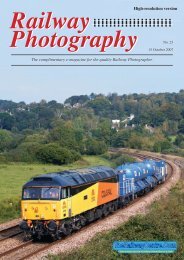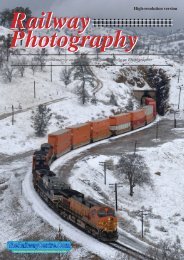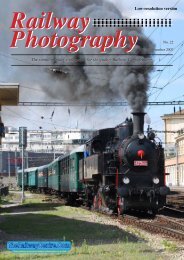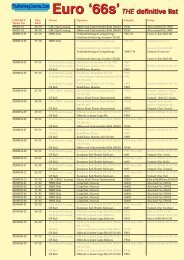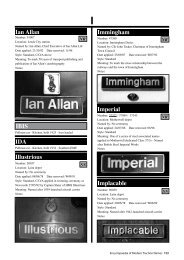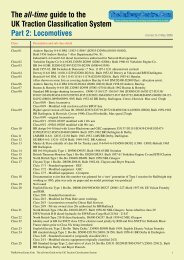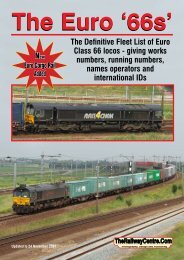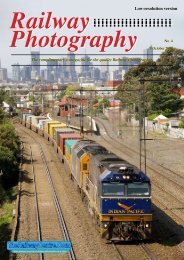Download High Resolution file 6mb - The Railway Centre.Com
Download High Resolution file 6mb - The Railway Centre.Com
Download High Resolution file 6mb - The Railway Centre.Com
- No tags were found...
You also want an ePaper? Increase the reach of your titles
YUMPU automatically turns print PDFs into web optimized ePapers that Google loves.
<strong>Railway</strong>Photography<strong>High</strong>-resolution versionNo. 613 November 2006<strong>The</strong> complimentary e-magazine for the quality <strong>Railway</strong> Photographer<strong>The</strong><strong>Railway</strong><strong>Centre</strong>.<strong>Com</strong>Your primary source of railway information at a click
<strong>Railway</strong>PhotographyNo. 613 November 2006On the Cover<strong>The</strong> complimentary e-magazine for the quality <strong>Railway</strong> PhotographerTwo pairs of Swiss <strong>Railway</strong>(SBB) Class Re 4/4 and Re6/6 combinations with No.11347 leading pass Rodi-Fieso with a northboundfreight on the southernSt.Gotthard route on 2 June2005Brian StephensonContentsWelcome and contentsNow lets get it straightSelect Image - Beaconsfield<strong>Railway</strong> PictorialA look at the Hungarian Scene<strong>The</strong> World in MonochromeFrom a Different ViewpointSubmissions to<strong>Railway</strong> Photography2346121416<strong>The</strong> publishers of <strong>Railway</strong> Photography- <strong>The</strong><strong>Railway</strong><strong>Centre</strong>.<strong>Com</strong> Ltd - welcomesubmissions for inclusion.We are looking for high resolution,good clear, but above all sharp imagesof any railway subject. Submissionsshould be sent by email in the .jpgformat to rp@therailwaycentre.complease make sure that attachments areno larger than <strong>6mb</strong>. We are happy toreceive high-quality scans of negativesand slides. With all submissions pleasemake sure you include your name andfull details about the picture, includingcamera and exposure details.As <strong>Railway</strong> Photography is distributedfree of charge, we are unable to offerreproduction fees.We are happy to consider smalleditorial features on aspects of railwayphotography.Thank you to all the readers who havesent e-mails about problems in takingpictures in the UK. Some 40 mails werereceived and in the main it looks as if theproblem is reducing with fewer majorproblems at the larger stations. However,people have reported being stopped by thecivil police while standing on or close tobridges with one reader arrested for failingto move after being asked.<strong>Railway</strong> Photography is going to trawl theviews of the TOCs and will report back inthe future. We suggest that you follow theATOC guidelines when wishing to takepictures and in the main this approachby the photographer seems to have littleproblem. Please remember not to use flashphotography when pointing the cameratowards a train.Recently a number of people have askedabout the pros and cons of using differentmanufacturers high-quality cameras,especially the comparison of results fromNikon and Canon models. Around 60per cent of the images in RP are taken onCanon, 30 per cent on Nikon and 10 percent on other makes. What are your viewson the Nikon v Canon question, if we getenough response we will put together aspread of comments from both sides.Colin J. MarsdenEditor2Editorial detailsEditor: Colin J. MarsdenDesign: TRC Publishing<strong>Railway</strong> Photography is published by<strong>The</strong><strong>Railway</strong><strong>Centre</strong>.<strong>Com</strong> LtdPO Box 45Dawlish, DevonEX7 9XYTel: 01626 862320E.Mail: rp@therailwaycentre.com<strong>The</strong><strong>Railway</strong><strong>Centre</strong>.<strong>Com</strong>Your primary source of railway information at a clickAbove: With the most wonderful autumn colours on the banks of the River Dart, <strong>The</strong> South Devon <strong>Railway</strong> heldits ‘Gronk Aid’ Gala on 4 November 2006 to raise money for the restoration of Class 09 No. 09002. <strong>The</strong> Devon DieselSociety’s Class 25 No. D7612 looking immaculate in 1960s green is seen near Staverton Bridge with a demonstrationfreight train. Nathan Williamson<strong>Railway</strong> Photography
Now lets get it STRAIGHTfrequent problem when taking pictures of locomotive or train nameA and number plates or pictures of drawings or items mounted on awall, is that you are unable to get directly ‘on’ to the subject and thus endup with a picture that is not square, looking as if the picture is either topor bottom heavy. A number of ways are available to digital photographersto reduce and virtually eliminate this problem.If you are using Photoshop CS to edit illustrations a very simple touse tool is available, however, it is one seldom used by non-professionalusers and its location is a little hidden with a non-too helpful <strong>file</strong> name‘Distortion’, in fact it does the very opposite.Once you have opened your image which needs correcting inPhotoshop, and you have performed any basic editing, such ascolour and level correction, before you make any image trim go toFilter>Distort>Lens Correction, after a few seconds depending on theamount of RAM your computer has, a new window will open, with yourpicture with a small square grid all over it.On the right side of the screen are a number of editing options. If youhave taken your picture either looking up or down at it you will need touse the ‘Transform Vertical Prospective’ slide tool, do this very carefullyas a little adjustment goes a long way and it is easy to over correct.You might also need to make a slight adjustment on the ‘TransformHorizontal Prospective’ slide, especially if your original illustration wastaken with the camera looking slightly left or right.Once you have made the corrections, and the grid will tell you wheneverything is back to square, press the OK button and the image willopen in a normal Photoshop window. As this correction effectively makesuse of layers, you will have to flatten the image before further use. Oncethis is done, you can then trip the image to the desired size and yourpicture will be as near as possible to the correct prospective.CJMExample 1:In this picture of a drawing, (the original un-edited versionis shown below), it was impossible to get at the correct angleto get a true prospective. By making the Filter>Distort>LensCorrection then Transform Vertical Prospective alterations, plusa trim, has produced a finished image (left), very close to theoriginal painters work.A number of other adjustments are also available in theFilter>Distort>Lens Correction menu, such as ‘Lens Distortion’, thisslide adjustment allows an image with convex or concave sides or topto be straightened.‘Chromatic Aberration’ can also be fixed using two slide options, onecovering the red/cyan fringe and the other the blue/yellow fringe.Some, usually the more low price lenses, but not often seen thesedays is Vignetting, where dark or light edges or curves are found. Acorrection tool for this is also available and from the limited use I havehad of this tool the results are excellent.<strong>The</strong> angle of the picture relevant to the frame can also be adjusted,but in most cases this is best done after the other corrections have beenmade in the usual Photoshop menu.<strong>The</strong> main grid displayed over your image can be adjusted to suityour personal choice, adjustment to size and colour is available by abottom menu bar. It is always worth using a grid of distinctive colourcompared with the main subject colour of your image. Always use asmall grid, as its easier to notice even a slight angle to a line.For anyone interested in ‘playing around’ with effects, the Photoshopfilter menu offers hours of harmless fun, imposing flair, variousdistortions, double images, virtually anything can be done. But as ageneral word of caution, always work on a copy <strong>file</strong> of the original,never work on the only copy of an image you have, as if you save theimage it will overwrite your one and only copy and no way yet existsto recover the image once overwritten. Over the coming months wewill try out and show some of the various filter and graphic optionsavailable in Photoshop. Other photo editing software packages alsooffer a limited amount of filtration. A number of Photoshop plug-insare also available to do numerous effects to images, some of which aredownloadable from the Adobe website or third party suppliers.Example 2:In this picture of a train nameplate the position from which it was taken on the trackside produceda very angled image and one which was not suitable for reproduction. <strong>The</strong> image was first openedin Photoshop and colour corrected using the levels and curve tool. <strong>The</strong> image was then savedand opened again and then run through the Filter>Distort>Lens Correction and TransformVertical Prospective settings. In this case the major adjustment was in the vertical plane, but somehorizontal adjustment was also needed to give the near head-on prospective.<strong>Railway</strong> Photography 3
Select Image - BeaconsfieldBy Kim FullbrookThis short feature describes how a photograph was captured and theresulting image edited on a computer afterwards to correct faultsand make improvements.On Wednesday 11 October 2006, Class 67s Nos. 67029 and 67006operated a special passenger train from Marylebone to Wrexhamand return. <strong>The</strong> rumour mill at the time suggesting it was a trial for apossible future ‘open access’ train service. With scheduled diesel locohauled passenger workings on the Chiltern Line having been extinctsince 1990 apart from the occasional railtour, this rare photo opportunityhad to be taken.<strong>The</strong> return working was booked through the Chilterns atapproximately 18.00. In mid-October there is little light at this time andthe poor weather on the day meant the light level would be particularlylow. It would be a struggle to find a location that allowed sufficientshutter speed to ‘freeze’ the train movement while also providingsufficient light to give a correct exposure. <strong>The</strong> only viable choice wasthe footbridge east of Beaconsfield station. Here the use of a moderatetelephoto lens to give a fairly head-on composition of a train passingthrough the station meant that a low shutter speed could be used. <strong>The</strong>lights from the station and car park would add some extra light andbackground interest. With a high ISO setting and the camera mountedon a tripod to avoid shake it should just about be possible to get apicture without severe under-exposure and a blurred subject.A Canon EOS 5D camera with Canon EF 200mm f2.8L lens wasused, allowing the use of a f2.8 aperture setting while still achievingexcellent sharpness. A Gitzo carbon-fibre tripod, sturdy ball head andRRS mounting plate system would all serve to reduce the likelihood ofany camera shake. Of additional note was the use of a remote shutterrelease to avoid the risk of shaking the camera by the act of pressing theshutter button. Test shots of units before the train arrived showed thatthe concept could work and an exposure of 1/90 sec @ f2.8 at 1600 ISOwas chosen. Normally such a low shutter speed would mean terriblespeed blur but the distance from the train and head-on angle wouldreduce the impact of any blur. Manual exposure control was used toavoid any autoexposure system being confused by deep shadows or thetrain headlight.Unfortunately just after receiving a message saying that the specialtrain was close, the light level dimmed further. An even slower shutterspeed was not feasible due to the noticeable speed blur this would cause,so the only option was to under-expose. On Canon cameras the 3200 ISOsetting is a slight ‘cheat’ and in reality is only 1600 ISO underexposed.<strong>The</strong>re was therefore no point in setting the ISO to 3200. When the traincame the histogram was well short of the right side, indicating significantunderexposure. This would increase the amount of noise on the finalimage. However, Canon SLR cameras have relatively low noise atthese settings anyway and the use of raw format would allow plentyof processing options on the computer. Another problem was that aunit travelling in the opposite direction arrived at a bad time just as thespecial was approaching the ‘right’ position and filled the bottom left ofthe picture. This would be a compositional disaster when using film butcould be removed in Photoshop. <strong>The</strong> method chosen was to take a shotwithout the unit and during editing to overlay the empty track on top ofthe unit.4<strong>Railway</strong> Photography
u Covering up some ghost reflections caused by flare using the cloningtool. <strong>The</strong>se covers go in a new layer.u Increasing the contrast slightly in the whole image using a LevelsAdjustment.u Darkening the sky slightly using a Curves adjustment.u Brightening just the train body slightly. <strong>The</strong> area is limited to just thetrain using a mask.u Saving the Photoshop format <strong>file</strong>.u Resizing, cropping, sharpening and saving a Jpeg format image.A view of the Layers Palette is shown below. Note that certain layershave a mask to restrict their effect. When looking at the Layers Palettethe description should relate it to the stages described above. White onthe mask indicates where that layer or adjustment takes effect, and blackelsewhere.Overall the editing process has made a huge difference and created anatmospheric image. <strong>The</strong> distracting unit has been removed, the subjecthas been lightened, flare removed and the contrast increased in keyplaces. Viewed close up there is still noticeable noise but we have toremember that this result would have been near-impossible using film.On the computer the various stages are as follows:u Converting the raw format loco image to a Tiff <strong>file</strong> using the CanonDPP Raw Converter. This step includes increasing the overall brightness.u Converting the raw format image of the plain track to a Tiff <strong>file</strong> usingthe same settings in DPP so that the two images match.u Reading both images into Photoshop CSS into separate layers,choosing to put the empty track layer above the train layer.u Blending the two layers together to cover up the unit with the plaintrack. This is done using a mask. Initially the mask is all-black and noneof the track layer is visible. By replacing the black mask with white usingthe Eraser, the track layer begins to appear. A soft brush is used to ensuregradual edges to the mask. Because a tripod was used when taking theimages initially they align perfectly.Its time again for those wonderful autumn tintsEvery Fall (Autumn) Pennsylvania Railroad E8s power a special train from Harrisburg to the fall festival in Renovo, Pennsylvania, following the SusquehannaRiver valley. In 2006 it ran on Saturday 14 October headed by the splendid ex-PRR E8s Nos. 5711 and 5809. <strong>The</strong>se 2,250 hp diesels were built in 1951/52by EMD and are now owned by Bennett Levin and normally kept in the Juniata Terminal Railroad in Philadelphia. <strong>The</strong>y were part of an order of 74 E8s placedby PRR with EMD. <strong>The</strong>y are seen passing the yard at Lock Haven, Pennsylvania. Chris TaylorPhotographic details: Camera: Canon 300D, Lens: Canon 18-55mm EFS zoom at 34mm, ISO: 200, Exposure: 1/640 @ f9<strong>Railway</strong> Photography 5
Above: What an impressive looking train! <strong>The</strong> Class R598 or Nexios DMU sets formed into three car units were built by CAF in Spain and are operatedby Spanish <strong>Railway</strong>s RENFE. <strong>The</strong> set illustrated on 5 October 2005, is operating a service connecting Vigo in Portugal with Coruña in Galiza, Northern Spain.<strong>The</strong>se sets have a top speed of 160km/h and are fitted with a tilt system. Power is supplied by six MAN engines, four for traction and two for hotel power. <strong>The</strong>yare only used for fast connections between principal cities. Pedro CostaPhotographic details: Canon Powershot G6, ISO: 100, Exposure: 1/320 @f56<strong>Railway</strong> Pictorial<strong>Railway</strong> Photography looks forward to receiving yourpictures for inclusion in these pages, please sendhigh-resolution images to RP@therailwaycentre.com andshare your work with others.Below: It has been documented by many people that the front ends of the Class 444 and 450 ‘Desiro’ sets are the same, however this is not the case as will be seenwith this passing view of the two classes at Byfleet & New Haw on 27 October 2006. <strong>The</strong> bodywork below the main headlights on the ‘450’ is recessed to housesupporting brackets for the gangway connection, whereas this is not the case on the Class 444. <strong>The</strong> livery is also different. Set No. 450009 forms an ‘up’ serviceto Waterloo, while No. 444024 heads for Portsmouth. Chris NevardPhotographic details: Nikon D200, Lens: Nikkor 80-200mm ED zoom at 200mm, ISO: 250, Exposure: 1/800 @ f46<strong>Railway</strong> Photography
Above: On 4 April 1980, rail blue-liveried ‘Crompton’ No. 33015 passes over Hampton Court Junction, south of Surbiton powering the 07.45 Salisbury toWaterloo ‘West of England’ express. <strong>The</strong> train was formed of eight Mk1 and Mk2 coaches complete with a full buffet car. In the background is Hampton Courtflyover, taking the down Hampton Court line over the South West main line tracks. Colin J. MarsdenPhotographic details: Camera: Nikon FM2, Lens: Nikkor 50mm f1.4, Film: Kodachrome 64, Exposure: 1/500 @ f5. Slide scanned on NikonCoolscan 9000 at 500dpiBelow: In the photographer’s own words “this shot of the RHTT, proved more rewarding than the conventional view that I took of the train on approach! Ofcourse it would not be suitable for ‘print’ in any magazine.” <strong>The</strong> image of DRS Class 37s Nos. 37069 and 37602 are shot almost directly into the sun headingfor Wrexham on route to North Wales on November 1. <strong>The</strong> spray from the train being backlit, shows just how extensive it is. <strong>The</strong> train is approaching a levelcrossing, so anyone standing too close will end up soaked! Mark RileyPhotographic details: Camera: Nikon D50, Lens: Nikon 70-300mm zoom, ISO: 400, Exposure: 1/1250 @ f6.3. RAW format, exposure +0.3ev,saturation +2<strong>Railway</strong> Photography 7
Above: <strong>The</strong> placing of the train within the general landscape or industrial scene always helps lift a ‘railway view’ into a ‘picture’. Here the photographer hasincluded the gate and trackwork into Heck sidings on the East Coast main line, while photographing GBRF Class 66/7 No 66714 powering the 11.50 Selby toFelixstowe on 22 August 2006 Mark AllattPhotographic details: Camera: Canon EOS30D, Lens: Canon 28-105mm zoom at 105mm, ISO: 100, Exposure: 1/640 @ f5.6Below: <strong>The</strong> use of flash photography in daylight shooting is something viewed as ‘unusual’ however, there are times when the extra ‘light’ helps lift a picture.Here Silverlink Metro No. 313103 waits at the soon to be closed North Woolwich station forming the 12.07 service to Richmond on 18 October 2006. <strong>The</strong>inclusion of the station lights and a low prospective improves the composition of this image. Chris NevardPhotographic details: Camera: Nikon D200, Lens: Nikkor 28-70mm IFED zoom at 28mm, ISO: 200, Exposure: 1/250 @ f10. (Fill in flash was usedfrom a Nikon Speedlight SB600. Two RAW transfers were made, one for sky and one for foreground, combined in Photoshop CS2 with a 200 pixel feather)8<strong>Railway</strong> Photography
Above: With the winter months with us, and a greater need for EWS traction resources, the ranks of Class 60s have increased, with 70 locos officially in operationalstock on 8 November 2006. On 2 October 2006, in perfect photographic conditions No. 60013 passes Elsham on the line between Scunthorpe and Barnetby,powering train 6E32, the 08.47 Preston Docks to Lindsey empty bogie tanks. This loco now sports the rather ugly EWS animal head logos stuck on the bodyside,covering up the old Trainload Freight decals. Warren ArmstrongPhotographic details: Camera: Fuji S2 Pro, Lens: Nikkor zoom at 70mm, ISO: 200, Exposure: 1/500 @ f5.6Below: <strong>The</strong> taking of images virtually directly into strong sunlight, as long as the main blast of sun is kept out of the camera lens can often produce some excellentresults, however the photographer would have to use their knowledge on exposure as the light meter is unlikely to be a lot of help. FGW Adelante No. 180103forming a Paddington to Oxford service overtakes Freightliner Class 66/5 No. 66540 powering the Southampton (Millbrook) to Leeds container service on 3 October2006 in the Thames Valley near Pangbourne. <strong>The</strong> photographer notes ‘<strong>The</strong> lens was shielded from the low head on light by tucking into the branches of the adjacentconker tree”. Tony CallaghanPhotographic details: Camera: Canon EOS30D: Canon 70-200mm zoom at 200mm, ISO: 100, Exposure: 1/640 @ f5.6 (-1EV) Taken in RAW andprocessed through Bibble Pro and Photoshop CS<strong>Railway</strong> Photography 9
Above: Night photography under the great roof at Isambard Kingdom Brunel’s Paddington station has always been a long favourite with the editor of RP. This timeexposure shows the present decoration to the structure to good advantage, with the side and central lighting showing up the structure. <strong>The</strong> centre lights having a ‘starburst’ effect adds to the quality of the image. <strong>The</strong> picture shows FGW ‘Turbo’ No. 166221 resting between duties in platform 4 on 6 October 2006 at 23.45 hours. <strong>The</strong>photographer notes “that the image was taken on the way home from the pub, and I always set the camera to shutter delay to avoid camera shake by doing this afterpressing the shutter, it will fire 10 seconds later”. Richard StilesPhotographic details: Camera: Canon EOS30D, Lens: Canon EF 18-55mm at 18mm, ISO: 200, Exposure: 30 sec @ f18 (Processing: Raw formatthrough Neat Image and Adobe Photoshop)Below: At the time of taking on 1 December 1991, this would have been a ‘hot news’ picture, today it serves as a reminder of the past when failures of booked tractionwere not infrequent and rare power was substituted. In this view at Oxford, Class 37/9 No. 37905 arrives with a late running Hereford-Paddington service followingfailure of the booked engine. <strong>The</strong> photographer remarks “the 37 was taken off at Oxford and replaced by Class 47 No. 47581, after this picture was taken I waited and58004 rolled in powering the Glasgow-Brighton service piloting No. 47808 which had also failed”. Wayne WalshPhotographic details: Camera: Canon T90, Lens: Canon 50mm, Film: Kodachrome 64, Exposure: 20sec @ f16. Negative scanned on NikonCoolscan V<strong>Railway</strong> Photography 11
A look at the Hungarian sceneIllustrations by Hungarian <strong>Railway</strong> photographer Ferenc JooAbove: Taken at Csajág stationthis low-level viewpoint ofClass M47 No. 1307 working apassenger service includes someof the local flowers, withoutdetracting from the mainsubject. M47 1307 is a dieselhydraulicoriginally built 1974but now fitted with extra ballastweights.Photographic details: CanonPowershot A85, ISO: 100,Exposure: 1/1000 f2.8Left: Many of the local orbranch line services in Hungaryare operated by this type ofBzmot single car multiple unit.Here car No. 183, painted inthe traditional red and yellowlivery traverses the atmosphericbranch line between Körmendand Zalalövő in WesternHungary on 21 August 2006.Photographic details: CanonPowershot A85, ISO: 100Exposure: 1/50 @ f4.512<strong>Railway</strong> Photography
Above: Sunset at Aszófő, the slab sides of the Hungarian <strong>Railway</strong> (MAV) coaches pick up the last rays of the setting sun while working a ‘fast’ train servicefrom Tapolca to Budapest, making a stop in Aszófő, on 10 October 2006.Photographic details: Canon Powershot A85, ISO: 100, Exposure: 1/500 @ f4.5Below: Many of the main line electric services in Hungary are powered by the ‘Universal’ V43 class of 25kV Bo-Bo, built from 1963 with a fleet size of 379.Today around 300 still remain operational. On 5 August 2006, V43 No. 1191 powers a Budapest to Szombathely express service, among summer fields nearHerend.Photographic details: Canon Powershot A85, ISO: 100, Exposure: 1/640 @ f4<strong>Railway</strong> Photography 13
Above: Wouldn’t it be wonderful if we had trains such as this to see and capture today? On 4 March 1980, as part of a power trial in the Westbury area, Class50s Nos. 50011 and 50024 were used to operate a Merehead to Acton loaded Foster Yeoman stone train, formed of 4-wheel PGA hoppers. <strong>The</strong> train is seentraversing the ‘up’ slow line near Twyford. Colin J. MarsdenPhotographic details: Camera: Mamiya 645 1000S, Lens: Mamiya 80mm, TriX at 400ASA, Exposure: 1/1000sec @ f5.6. Negative scanned onNikon Coolscan9000 at 500dpi.<strong>The</strong> World in MonochromeBelow: <strong>The</strong> area around Foxlow Junction and Barrow Hill is today but a shadow of the rail network and traffic levels seen in the past. On 30 June 1983, railblue-liveried Class 47/3 No. 47372 approaches Foxlow Junction with a short train formed of MGR wagons off the Hall Lane spur. <strong>The</strong> wagons had been collectedfrom nearby plants and were on route for repair. Colin J. MarsdenPhotographic details: Camera: Mamiya 645 1000S, Lens: Mamiya 80mm, TriX at 400ASA, Exposure: 1/500 @ f4. Negative scanned on NikonCoolscan9000 at 600dpi.14<strong>Railway</strong> Photography
Above: Very careful positioning of the relieving driver at Reading has made this an interesting silhouette. By slight under exposure of the original image thephotographer has made the loco and driver stand out against the bright background. <strong>The</strong> picture shows Old Oak <strong>Com</strong>mon-based Class 47 No. 47596 working the11.20 Paddington-Oxford, on 18 May 1991 at Reading. <strong>The</strong> photographer said in his notes “I waited for the driver to reach for the handrails before taking theimage, to give a better effect. I was almost lying on the platform at the time - the things you do for a good picture”. Craig ShurmerPhotographic details: Camera: Mamiya 645 Pro, Lens: 80mm, Film: Kodak Tmax @ 100ASA, Exposure: 1/500 @ f6.7 (underexposed by 2 stops)Scanned on Canscan 8000F at 500dpi.Below: In years past, when a photographer was out on the lineside, before the days of mobile phones and ‘gen lists’, he had no prior knowledge of what was about topop around the corner. One case was on 28 June 1983, when out on the Midland Mainline at Normanton-on-Soar, when this quite amazing triple header of brandnew Class 58 No. 58002 piloting Class 31s Nos. 31224 and 31238 came into view. <strong>The</strong> Class 58 was on test from Toton during the classes first week of main lineoperation. Colin J. MarsdenPhotographic details: Camera: Pentax 6x7, Lens: Pentax 105mm, Film: Kodak Tri-X @ 400ASA, Exposure: 1/500 @ f6.7. Negative scanned onNikon Coolscan9000 at 600dpi.<strong>Railway</strong> Photography 15
From adifferentviewpoint......Above: Enhanced by the use of a Lee 85c warmup filter together with a Lee Sunset Red filter, thisview of a Virgin Voyager Class 221 was captured ona Northbound service, crossing the River Tame, atWychnor viaduct, near Alrewas on 9 September 2004.Phil GrainPhotographic details: Camera: Mamiya 645 Protl, Lens: 80mm f2.8, Film: Fuji Provia 100, Lee85C warm up filter (Orange) and Lee Sunset Redfilter. Exposure: 1/500 @ F2.816<strong>Railway</strong> PhotographyLeft: Definitely a slightly ‘different’ view, here thephotographer has caught the train as displayed in thedriver only operation tv screens at Harringay. <strong>The</strong> trainis Class 313 No. 313043 arriving at Harringay on 18October 2006. <strong>The</strong> photographer records “the light wasawful so not much else to photograph, so I took thisview across three tracks.” <strong>The</strong> four screens provide aview of the entire train to the driver, enabling him tosafely operate the passenger doors and self dispatch hisown train. It is interesting to see the reminder to thedriver to ‘Check Signal Aspect’, especially useful as thedriver is looking out the side of the train and might nothave observed any change of aspect. Mark BeartonPhotographic details: Camera: Canon EOS 20D,Lens: Canon zoom at 175mm, ISO: 200, Exposure:1/60 @ f2.8
Right: ‘Impact’, ‘Dirtiness’ and ‘History’ is how thephotographer described this illustration, taken at StratfordDepot in East London in mid 1982. Taken on slow speed film,with the bright sunlight streaming through the shed roof, picksup every little detail and grain of dust on the side of the hulk ofClass 40 No. 40036. <strong>The</strong> locos original number 236 can be seenpainted over, while the taped on ‘Exceptional Load’ label showsthe loco to be awaiting transfer to BREL Swindon for cuttingup. Wayne WalshPhotographic details: Camera: Canon A1, Film:Kodachrome 25, Exposure: not recorded. Negativescanned on Nikon Coolscan VMiddle: A fascinating view of ‘still life’ with a railway flavour.A Czech route indicating point lever, after a fall of snow. Herethe photographer could so easily have exposed for the black areaand lost the detail of the snow, or conversely, the snow exposurecould have been correct, underexposing the point equipment.Ian CowleyPhotographic details: Camera: Nikon Coolpix 8700, ISO:200, Exposure: 1/500 @ f4.8.Below: Some of the most wonderful sunsets can be recorded inmid-California, especially around Sandcut and Bakersfield. Herea southbound UP ‘baretable’ train approaches Sandcut on 19October 2006, with the headlight of the following train loomingup in the distance. <strong>The</strong> orange sky has not been enhanced, thisis the natural recorded colour. To reduce unwanted flair off theheadlights, the lens filter was removed. Colin J. MarsdenPhotographic details: Camera: Nikon D2X, Lens:Nikkon 28-70mm zoom at 60mm ISO: 200, Exposure:1/640 @ f5.6Back Page: This is the aftermath of a serious freight derailmentat Maidstone East, early in the morning of 6 September 1993,when a driver, who had been drinking, failed to reduce the speedof his train, the 01.29 Dover-Willesden powered by Class 47 No.47288. <strong>The</strong> train went into derailment and destroyed part of thestation. <strong>The</strong> loco ended up on its side towards the London end ofthe platforms. Wayne WalshPhotographic details: Camera: Canon A1, Film:Kodachrome 25, Exposure: not recorded. Negativescanned on Nikon Coolscan V...<strong>Railway</strong> Photography 17



